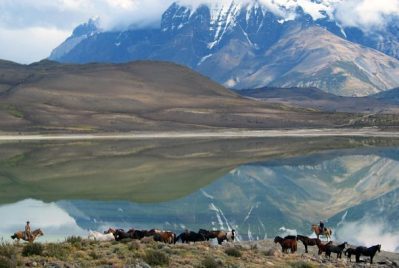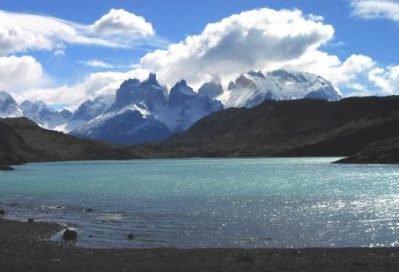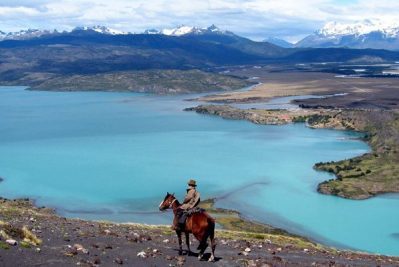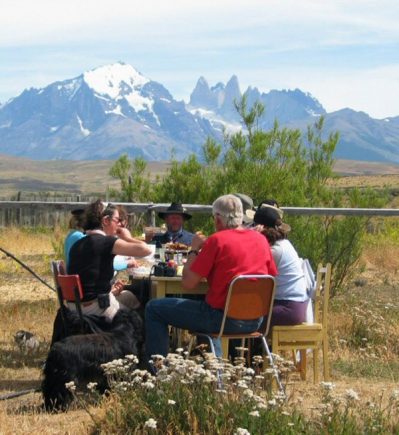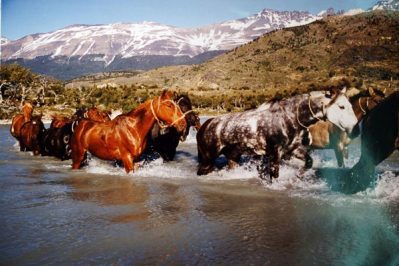Of Criollos and Camaraderie
Horses and riders cantered swiftly through the swirling mists and windblown rain of Chilean Patagonia, concentrating on the winding path ahead. Warm food and a hot shower were still several miles away. A loud shout from the left caused me to look in that direction and the image I saw seared into my memory like a picture from the past that is always remembered. Several hundred meters away, behind the nearby riders, huge, sky-blue slabs of vertical ice towered over the large beech trees on the edge of Rio Grey. The foggy, dream-like scene, with moving riders, silhouetted trees and blue icebergs, was filled with an ethereal quality. The wind and rain made picture-taking impossible, but this was ‘the” picture – with a stunning backdrop that said, “Welcome to horseback riding in Patagonia!”
At the end of the earth, near the southern tip of South America, in Chile’s southernmost Region De Magallanes, lies Torres Del Paine National Park. The centerpiece of the park is the Paine massif, a giant dome of pink granite capped by resilient black shale. Here, primeval forces combined to thrust cloud-wreathed towers (torres) and rocky horns (cuernos) 10,000 feet out of the surrounding steppes in one mind-boggling vertical leap.
This is the Chilean part of Patagonia, a land so immense where everything – including horseback riding – seems otherworldly and surreal. Minutes after adjusting our stirrups, tying on rain gear and starting our ride, sounds of a thunderous avalanche reverberated from nearby Mt. Almirante Nieto. Over the next 9 days, the roaring noises from several other avalanches came to us from the snow gods high up on other mountaintops.Near Lago Nordenskjold and Lago Azul, brown and white guanacos, wild camelids that are related to the better-known Alpaca and Llama let us approach on horseback, then emitted their turkey-like gobble and trotted off.
In this remote park, we learned firsthand why the outfitter rides the low trails and, for the most part, eschews the high ones. The notorious Patagonian winds can blow so hard (over 50 MPH) that a horse must lean into the wind, just like we do. We saw conditions that, when quartering into heavy wind on the open plains, the Chilean Criollo horse knows instinctively to turn its body into the wind, while trotting sideways. Even on mild days, the strong, upper winds blew snow plumes off the mountain peaks above us, creating long white trails in the sky that billowed like smoke from a fire. Seeing that, we were glad to be hidden down in the more-protected valleys and forests.
Descending from horses imported by the Spanish conquistadors and evolving as the horse of the Pampas, the small South American Criollo horse is muscular, hardy, adaptable and independent. It is bred to trot all day for the baqueanos (South American wranglers) that watch over the herds of sheep and cattle on the large estancias (ranches) surrounding the park. Their stamina is legendary and they worked tirelessly for us, even at the end of a hard season of riding. We rode 35–40 Kilometers on hard travel days, which meant that after negotiating 20 kilometers of steep, rocky, muddy mountain trails, they cantered and trotted the last 15-20 kilometers on open plains like Olympic athletes completing an easy training run! For us, this was thrilling, being able to canter and trot for miles across open country wonderfully absent of prairie dog holes, fences or other dangers that plague the North American landscape. After a few moments rest, the amazingly hardy Criollo was ready to go again.
On this camping version of the 10-day Glacier ride, we quickly became one with our trusted mountain horses, as they bore us to the stunningly beautiful, remote areas of the park seldom seen by trekkers and other road-bound tourists. The longer horse trails circumvented the inner trekking trails, so we felt completely alone and at peace as we rode. It was only in several refugios that we encountered other travelers this late in the season (the end of March). In Patagonia, like other truly remote areas at the ends of the earth, distances traveled in these huge valleys are often measured in days, not in hours. In every open plain, we cantered for what seemed like forever, many times making our own trail in the wide-open terrain, not content with following the trail of others. By the second day, we cantered so far and had so much fun that one of our group exclaimed later, ” We cantered our brains out.”
We trotted the winding trails, among the southern beech trees that exist in three varieties – from low alpine shrubs to tall, stately trees. We walked up and down steep, rocky slopes, forded streams, slogged around and through deep, muddy bogs and swam rivers. (Actually, the horses swam the glacial rivers. The gear and people were ferried across in a leaky rubber raft.)
Silently, we rode by jade-green lakes, surrounded by gaunt, gray skeletons of burned trees, the contorted remnants of past fires (many man-made). In one of these particularly beautiful spots, on the trail called the “Up-and-Over”, Mother Nature’s magic moved several riders to tears, as the sublime beauty of jewel-like lakes, numerous barren tree trunks and the omnipresent backdrop of an overarching mountain massif overwhelmed their emotions.
In a region where one must be prepared for all types of weather conditions, we experienced just about everything. The first three days had some bad weather that really tested our limits. The rest of the trip had plenty of blue-sky “polarizer” days, with some cloudy, cooler days mixed in – without much wind. When the weather was good, it was really good and we enjoyed and reveled in it immensely.
When the weather was bad, it was really rank. On day 3, riding back from Lago Pingo on a hard, all-day ride that covered 20+ miles, large globs of a snow/rain mix started falling from a leaden sky, pushed every which way by the infamous winds. The riders ensconced in their heavy, head-to-toe rain suits heard – and felt – the watery globs hit their suits and felt glad for the extra protection. Other riders, covered in varying degrees of lighter rain gear, had to hunker down into themselves like wet, water rats and draw on their warm, inner reserves.
As the trail turned into a slick, muddy quagmire, good mountain riding techniques were of paramount importance. On one particularly steep and rocky section, with hairpin turns and small cliffs, one rider got too close to a packhorse that stopped right above a bad section of slick rock. By not leaving enough space between horses, the horse and rider got caught midway up the slick rock, with nowhere to go. Instead of yelling at the packhorse to get going and giving her horse its head, the rider pulled back hard on the reins. This caused the horse to lose its balance and horse and rider toppled over backwards. The rider slid on her back into the mud and bushes along the trail and the horse ended up perched on the rock, with its leg through the reins. Having lost the reins and some pride, the rider, though experienced in show rings and jumping arenas was unsure what to do. The horse knew enough to just stand there and wait for help. Quickly coming to the rescue, one of the baqueanos steadied it enough to get the leg free and then led it to safety. Luckily, neither horse nor rider was injured in the fall. The lessons of leaving plenty of space between horses in tight or rough spots, giving the horse its head when it needs it and “gassing” your horse up the steep, slick rocks at the appropriate times were learned on that raw day.
The snug, quaint refugios were a pleasant surprise on the trip, as each night we had a dry place for eating, socializing and drying wet clothes. The refugios ranged from small 2-room huts to larger, hostel-like accommodations that had small kitchens, eating areas, showers and sleeping lofts. They also added a measure of safety, as several people lacking full raingear and waterproof gloves and boots could have become hypothermic had the wet, windy weather that Patagonia is renowned for continued for the duration of the ride.
With sunny weather and daytime temperatures in the 60’s (F), more beautiful riding days passed and we walked, trotted and cantered around Lago Azul and Lago Paine to the far northern region of the park. We camped for two nights at Refugio Dickson, surrounded by high snow-covered mountains, with a front row view of a large glacier. Here, horses must swim a milky, glacial river and then are turned out to graze on a grassy, tree-protected peninsula with the trekker’s foot trail barricaded to prevent their escape. (Note: the outfitter told us that they once did swim back across and made their break for freedom, but were rounded up by exasperated baqueanos miles away.)
On the next-to-last day, we retraced our steps from Dickson back to Lago Azul, then rode out of the park to a neighboring estancia. The horses will winter there on the open range. We were sad to say goodbye, but the horses were only concerned about the large, grassy meadows that we could see as we rode in. After a wonderful hot shower, we sat contentedly around an open fire with a large crucified lamb roasting over the coals. As the southern night sky enveloped us, we shared good wine and conversation. Tantalizing smells wafted around the fire and the Southern Cross shone brightly far above. As we had throughout the trip, we ate well on that last night. The succulent lambs, potatoes, salad, bread and dessert, washed down with Chilean wine, was a great ending to a well-planned and organized trip. It was obvious that Alec has done this many times, as he and his staff were always very attentive to our needs.
Our well-traveled group consisted of 6 guests, the excellent outfitter/cook, a delightful cook’s helper and 3 fun-loving, experienced baqueanos. Each person added a unique ingredient to the communal pot, melding our group dynamics into a special camaraderie broth. Of the guests, we had all true adventurers, masquerading at home as a vet, an artist, a vet tech, an equine journalist, a medical technologist and a database administrator. We were able to involve the baqueanos in some of our conversations, as several guests spoke good-to-fair Spanish and Alec was always available for translations. We laughed, told colorful stories, sang songs accompanied by really good guitar and harmonica playing, told jokes, looked out for each other, helped and kidded our fellow travelers – and when it was all over – we all realized that this wonderful trip touched our very souls.
After returning, we found many things about this trip hard to explain to people at home. Our pictures help, but they only go so far in explaining the grandeur and mystery of Patagonia. We tried to explain the fantastic, lenticular-shaped clouds, blown into oblong shapes by winds born in that wildest place – Antarctica. We tried to explain why the southern night sky seemingly has more stars and the meaning of the Southern Cross. We tried to explain how a riding trip like this could profoundly change some of our lives, renew our spirits and give us a new sense of direction. We tried to explain the eerie tree skeletons left standing throughout Torre Del Paine National Park, monuments to past man-made abuses to Mother Nature. And we tried to explain what the wonderful Criollo horse did for us, transporting us into another world – a Patagonian vastness – and the sense that this United Nations World Heritage site is truly a spectacular place – in a world full of special places.
Don and Marcia Lorenz
March 2001



